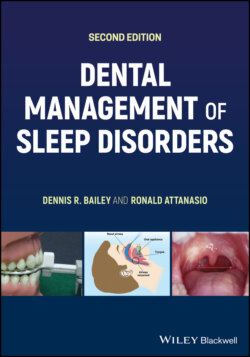Читать книгу Dental Management of Sleep Disorders - Ronald Attanasio - Страница 33
Cycles and Hours of Sleep
ОглавлениеDuring normal sleep the human cycles through the NREM and REM sleep stages four to six times a night. In the adult, regardless of the age, these stages occur at about 90‐minute intervals. In children, these stages are shorter occurring at about 50–60‐minute intervals. In addition, children have different proportions of REM and NREM sleep as well as the number of hours of sleep. A newborn typically sleeps 17–18 hours and 50% of this is REM sleep but by age 3 REM sleep diminishes and is now similar to adult levels [11]. At birth SWS is not present. It is first recognized between two and six months of age. SWS is typically more pronounced in young children, mainly because this is when growth hormone is secreted, appears to decrease after adolescence, and over time continues to diminish (Figure 2.2).
Typically after the age of 70 SWS is reduced and in some cases appears nearly nonexistent. In addition, the elderly may spend more time in bed and less time actively sleeping, also experience more sleep disruption, and there may be an increase in lighter stages of sleep, especially N1 sleep. An added consideration is that the reduction in SWS may be impacted by health‐related issues as well as the use of medications that may impact sleep. It has been reported that the reduced amount of SWS seen in the elderly may be associated with poor quality EEG signals associated with bone density of the skull [12] (Figure 2.3).
There are instances where as people become elderly they begin to adjust the time they go to bed to an earlier hour [13]. This results in waking earlier, a condition termed advanced sleep phase syndrome [14]. Here, the individual purposely adjusts the sleep–wake schedule by attempting to initiate sleep in advance of the circadian rhythm (CR) so the adjustment is not synchronized with the biological rhythm.
With the aging process sleep architecture may become altered with the appearance of more arousals and awakenings [15], subsequently resulting in an increased risk of sleep disorders, such as sleep‐related breathing disorders (SRBDs) and insomnia [16, 17]. With SRBD, the musculature that supports the airway may become more relaxed during sleep and this lends itself to increased collapsibility, increasing the potential risk for the SRBD. The role of the dentist is significant for the recognition of the SRBD especially obstructive sleep apnea (OSA) and the management of it with an oral appliance (OA).
The number of hours of sleep that is considered to be optimal varies with age. This has been reported by various professional organizations along with the National Sleep Foundation (NSF) [18]. Infants and young children require more as compared to teenagers, who require slightly more than adults (Table 2.1).
Figure 2.2 Sleep architecture/histogram over the ages.
